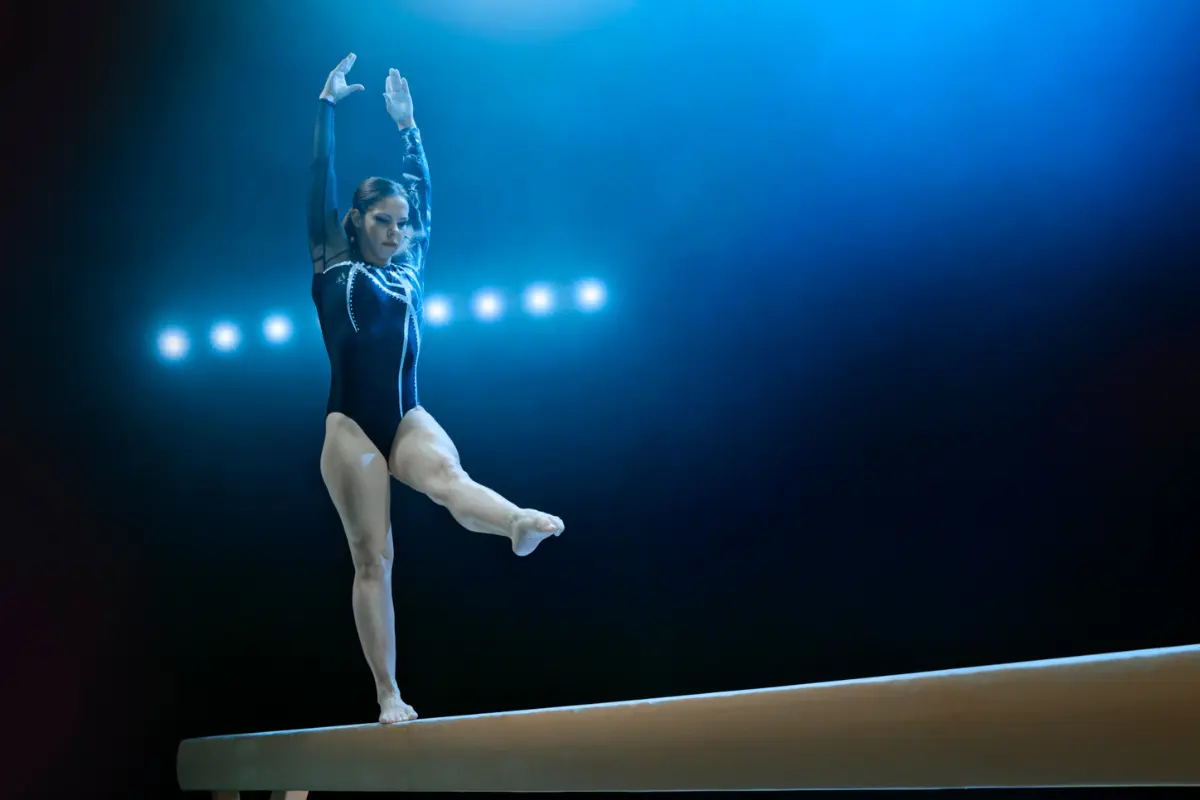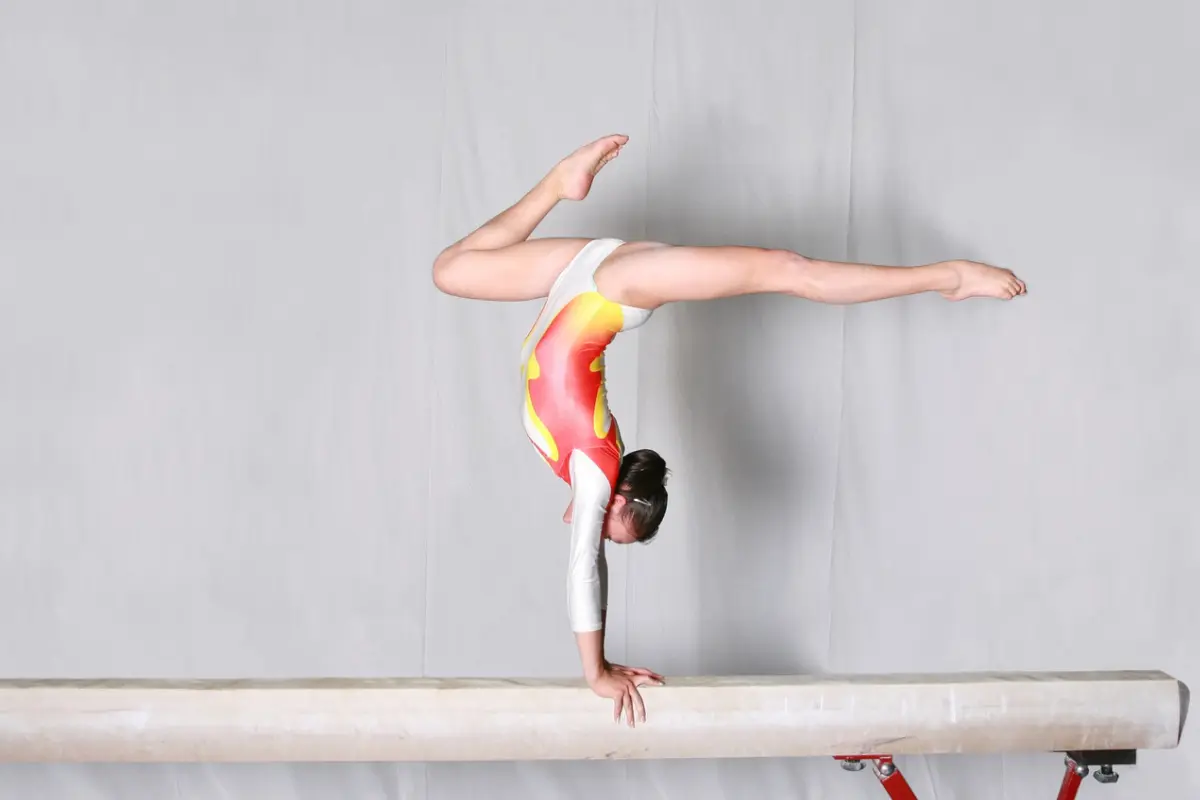In balance beam gymnastics, the first move onto the apparatus is more than a formality, it’s a performance statement. The mount not only starts the routine but also sets the tone for the entire presentation. A confident, well-executed entry signals control, artistry, and readiness, while a shaky start can instantly affect a judge’s perception.
Why the Mount Matters
Beam mounts aren’t just about getting onto the apparatus, they’re scored skills that can add up to 0.40 in Difficulty Value (DV), on par with many acrobatic elements. A well-executed mount demonstrates control, artistry, and confidence, while a poorly performed one can immediately cost valuable points.
What makes mounts uniquely challenging is that they’re often performed cold, straight from floor level, without a podium warm-up. That makes them one of the riskiest moments of the routine, requiring precision, body control, and smart planning.
Categories of Beam Mounts
Beam mounts fall into three broad types, each suited to different skill levels, routines, and choreographic styles.
1. Simple Mounts (Support Mounts)
Common in compulsory levels and lower Xcel divisions.
These focus on balance and control over difficulty, making them ideal for beginners or those prioritizing consistency.
- Step-On / Flank Mount (A – 0.10) – Step from the floor onto the beam with one foot, then bring the other up to stand.
- Front Support Swing to Straddle Sit (A – 0.10) – Swing one leg over from front support into a straddle sit, then rise to stand.
- Jump to Side Sit (A – 0.10) – Turn in mid-air and land in a seated side position on the beam.
While low in difficulty, these mounts are still judged for tight form, toe point, posture, and a smooth connection to the first skill.
2. Acrobatic Mounts (Acro Mounts)
Favored in upper optional, Xcel Diamond, and elite routines.
These involve inversion, flight, or rotation to create a bold entry. They boost difficulty and presentation value but demand precision.
- Cartwheel Mount (B – 0.20) – A sideways acrobatic entry, landing in a standing or seated position.
- Back Walkover Mount (B – 0.20) – Step into a walkover from floor or springboard, landing directly on the beam.
- Front Handspring Mount (C – 0.30) – A forward flight mount that lands on both feet.
- Round-Off + Back Handspring Mount (D – 0.40) – High-power combination entry, often used by elite gymnasts.
- Round-Off Layout Mount (F – 0.60) – A rare, high-risk entry combining a round-off with a layout landing on beam.
Acro mounts increase start value and add “wow” factor, but they demand absolute precision, small errors in alignment can cause big balance breaks.
3. Dance and Creative Mounts
Showcasing flexibility, originality, and artistry.
These mounts use body shapes, lines, and flow rather than explosive power, making them ideal for gymnasts who excel in performance quality.
- Split Jump Mount (A – 0.10) – Leap into a side split on the beam, absorbing the landing with control.
- Press to Handstand Mount (B – 0.20) – Press slowly to handstand and lower into starting choreography.
- Shoulder or Dive Roll (A/B) – Roll theatrically onto the beam, blending into the routine’s style.
Dance-based mounts work best when choreography flows seamlessly from entry into the rest of the routine.
Verified Difficulty Value Reference
Here’s a quick reference table for some of the most common mounts according to the FIG Women’s Artistic Gymnastics Code of Points (2025–2028):
| Mount Name | FIG Value | Points |
|---|---|---|
| Step-On / Flank Mount | A | 0.10 |
| Front Support Swing to Straddle Sit | A | 0.10 |
| Jump to Side Split / Straddle Sit | A | 0.10 |
| Squat / Stoop-Through Mount | A | 0.10 |
| Split Jump Mount | A | 0.10 |
| Press to Handstand Mount | B | 0.20 |
| Cartwheel Mount | B | 0.20 |
| Back Walkover Mount | B | 0.20 |
| Front Handspring Mount | C | 0.30 |
| Round-Off + Back Handspring Mount | D | 0.40 |
| Round-Off Layout Mount | F | 0.60 |
Source: FIG Women’s Artistic Gymnastics Code of Points 2025–2028 – Balance Beam, Group 1: Mounts.
How Judges Evaluate Beam Mounts
In competition, a beam mount is scored like any other skill—judges look at both its value and its quality of execution.
- Difficulty Value (DV) – Each mount has an assigned value in the FIG Code of Points:
- A = 0.10
- B = 0.20
- C = 0.30
- D = 0.40, and so on up to F for the most complex entries.
- Execution – Judges deduct for technical faults such as bent knees, flexed feet, uneven leg height, lack of body tension, shaky landings, or poor alignment during the mount.
- Artistry – Originality, rhythm, expression, and how naturally the mount transitions into the first element all contribute to the impression score.
Beginners benefit most from stable, low-risk mounts, while advanced and elite gymnasts can use their mount to gain DV and wow the judges.
When planned strategically and performed with authority, the mount becomes more than just an entry, it becomes the first highlight of the performance.






